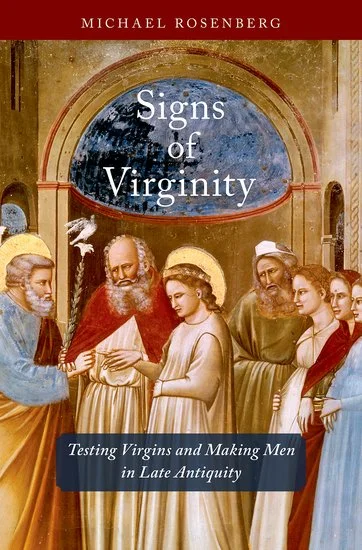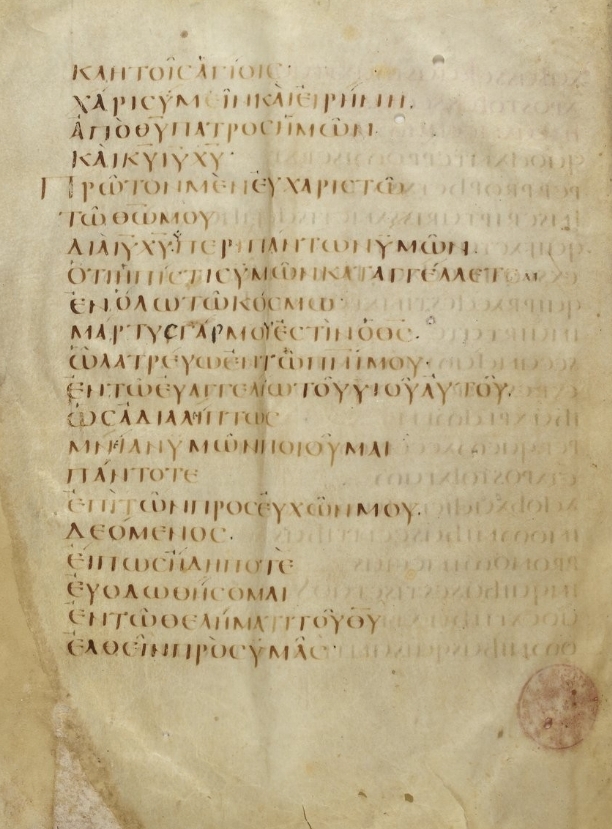Erich Gruen with a retrospective of his work: “If a consistent thread runs through my studies of Jewish history in the context of classical antiquity, it can be found in resistance to the common portrayal of Jews as victims.”
Read MoreBook Note | Signs of Virginity
Rosenberg’s book sets out to examine rabbinic paradigms of how virgin women’s bodies work, how the loss of that virginity happens, and therefore, what evidence proves the existence of virginity.
Read MoreWeek in Review (9/7/18)
Cover and first surviving page of the Syriac Life of Barsawma (d. ca.492) | Undated MS from Urfa | Image Source
Cover and first surviving page of the Syriac Life of Barsawma (d. ca.492) | Undated MS from Urfa | Image Source
This Week: Brent Nongbri, Dead Sea Scrolls fakery, looted antiquity raids, Call for Papers up the wazoo, ancient Arabs, excavation found footage – and more!
Read MoreA Manuscript of Exodus Wandering in the Wilderness
Ancient manuscripts are more than just carriers of texts. They are archaeological artifacts and deserve to be studied as such.
Read MoreWeek in Review (8/31/18)
The “Babylonian Map of the World,” Babylonian map on clay tablet (C6) | Found at Sippar, currently in the collection of the British Museum (BM 92687) | Image Source
The “Babylonian Map of the World,” Babylonian map on clay tablet (C6) | Found at Sippar, currently in the collection of the British Museum (BM 92687) | Image Source
This Week: Summer pedagogy forum, Bulgarian archaeology, early New Testament manuscripts, volcanic explosions, Museum of the Bible, chained books – and more!
Read MoreCharting the Course: Using Maps for Pedagogical Progress
Borders change, today and throughout history. Incorporating maps into the classroom encourages the students to view this for themselves and to begin to understand the myriad of ways that politics shapes geographical borders.
Read MoreDissertation Spotlight | Scribal Habits in Selected New Testament Manuscripts, Including those with Surviving Exemplars
At the core of the dissertation, three chapters analyze the scribal habits of the copyists of various manuscripts.
Read MoreWeek in Review (8/24/18)
Late thirteenth-century restored “Deisis” (δέησις) Mosaic | Hagia Sophia, Istanbul | Image Source
Late thirteenth-century restored “Deisis” (δέησις) Mosaic | Hagia Sophia, Istanbul | Image Source
This Week: Dunhuang manuscripts, calls for papers, Jewish foodways, ethnicity and the Peutinger Table, Shayna Sheinfeld on acting apocalypses – and more!
Read MorePerforming Apocalyptic Texts: Teaching the Eschatological Banquet from the Dead Sea Scrolls
The Wedding Banquet of Cupid and Psyche (1517) by Raphael. Villa Farnesina, Rome
The Wedding Banquet of Cupid and Psyche (1517) by Raphael. Villa Farnesina, Rome
“Performing the banquet shifted their analysis from the realm of the academic into the realm of something that is socially functional, assisting with student thinking about the ancient texts as representative of real people and their actions and beliefs.”
Read MoreBook Note | The Jewish Dietary Laws in the Ancient World
“To briefly sketch some of Rosenblum's findings, we see that Greek and Roman sources are often perplexed by or antagonistic to these laws, Hellenistic Jews justify the laws via allegory, reason, and revelation, Rabbinic sources only begin to provide justifications beyond revelation with the Amoraim, and later Christian sources return to allegory, while denying the literal adherence to these prohibitions.”
Read MoreWeek in Review (8/17/18)
Folio 1r from Hebrew Bible manuscript with Targum and commentaries | Bodleian Library Ms. Canon Or. 62, Oxford | Image Source
Folio 1r from Hebrew Bible manuscript with Targum and commentaries | Bodleian Library Ms. Canon Or. 62, Oxford | Image Source
This Week: St Catherine’s Monastery and digital humanities, multilingualism along the Nile, antiquities trafficking, philosopher monks, ethical philology - and more!
Read MoreHarnessing Creativity in a Biblical Studies Classroom
If Esther had a Pinterest, what would she post on it? If Ruth had a Spotify playlist, what songs would she include? What if Susannah joined the #metoo movement?
Read MoreDissertation Spotlight | The Apophthegmata Patrum and the Greek Philosophical Tradition
Instead of only studying one particular practice, I have taken the monastic path of life as a whole, as proposed by the Apophthegmata Patrum, from conversion to advanced practice, and analyzed it light of the philosophical schools.
Read MoreWeek in Review (8/10/18)
Early Islamic-period mosaic with elaborate floral and Nilotic mosaics | Church of St. Stephen, Umm ar-Rasas | Image Source
Early Islamic-period mosaic with elaborate floral and Nilotic mosaics | Church of St. Stephen, Umm ar-Rasas | Image Source
This Week: Sara Ronis kicks off August Pedagogy Month, extra-biblical Psalms, rabbinic conversion, Syriac #openaccess, late antique bullying – and more!
Read MoreLamenting a Broken World: Student Learning Through Creative Writing
In this creative assignment, students were empowered to engage with the biblical text in new ways: they understood some of the ways that biblical texts can relate to the modern world and vice versa, they used their own creative voices, and they reflected critically on why we must develop awareness of moments of pain and trauma in the world around us.
Read MoreBook Note | The Rabbinic Conversion of Judaism
Lavee argues for reading the conflicting attitudes of renewal and rejection as reflecting a Babylonian attitude of ‘genealogical anxiety,’ marking the convert as reborn so as to disassociate them from their natal families while in so doing marking them as the ‘eternal other.’
Read MoreWeek in Review (8/2/18)
Trellis-carpet mosaic segment, with animals | Lod Mosaic, Israel | Image Source
Trellis-carpet mosaic segment, with animals | Lod Mosaic, Israel | Image Source
This Week: Berzon’s response to Classifying Christians forum, apocrypha galore, Greco-Roman science, booksquashing and digital humanities, Lod mosaics – and more!
Read MoreOn Taxonomy and Classification: A Response
Throughout Classifying Christians, I proposed that Christian polemical ethnographers were operating both like physicists and anthropologists. In getting closer to the heretics—whether through personal or textual experience—the heresiologists actually made the terms of Christian culture both more and less clear.
Read MoreBook Note | Authority and Expertise in Ancient Scientific Culture
As a whole, the volume provides compelling evidence that various, interrelated “techniques of self-authorisation” were employed across (what the modern reader might categorize as) different scientific and technical genres, as a means not only for professionals to establish their credentials, but also for non-professionals to situate themselves in the social and political networks of the late Republic and the Roman Empire.
Read MoreWeek in Review (7/27/18)
Saint Ambrose and Augustine of Hippo | Altarpiece from Michael Wolgemut, Nuremberg c. 1495-98 | Image Source
Saint Ambrose and Augustine of Hippo | Altarpiece from Michael Wolgemut, Nuremberg c. 1495-98 | Image Source
This Week: Mira Balberg on Classifying Christians, heresy in Milan, Huqoq mosaics, scribality and the Dead Sea Scrolls, philology and provenance – and more!
Read More










![Gherardo Starnina - Thebaid, ca. 1420, Tempera on wood (Wikimedia Commons) [Sometimes attributed to Fra Angelico]](https://images.squarespace-cdn.com/content/v1/5449167fe4b078c86b41f810/1534121418493-UZ3BXHO6ZL8M70BB8Q17/Angelico%2C_tebaide.jpg)

![Southwest Texas McAllen Border Fence, Rio Grande Valley [ Photographer: Donna Burton ]](https://images.squarespace-cdn.com/content/v1/5449167fe4b078c86b41f810/1533738883693-XLDP3WL924ZNTV91Z2EM/32860951106_bc66460846_z.jpg)




